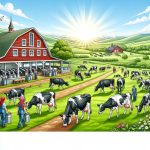
India has made great progress in many areas since gaining its independence in 1947, and the dairy industry has been essential in changing the rural economy. The transition of the dairy industry from small-scale subsistence farming to a large-scale commercial enterprise has improved rural incomes and sparked a broad socioeconomic development. This transition, which was sparked by a number of important initiatives and structural adjustments, demonstrates the significant influence dairying has had on India’s rural landscape.
1. The Genesis of the Dairy Revolution
The Indian dairy industry’s transformation began in earnest in the 1960s with the inception of the White Revolution, spearheaded by the National Dairy Development Board (NDDB) and its visionary leader, Dr. Verghese Kurien. The Operation Flood program, launched in 1970, was the cornerstone of this revolution. Funded initially by the sale of surplus milk powder and butter oil gifted by the European Economic Community, Operation Flood aimed to create a national milk grid, linking rural producers with urban markets.
2. The Cooperative Movement: Empowering Farmers
A key strategy of Operation Flood was the establishment and strengthening of dairy cooperatives. These cooperatives provided a structured platform for small and marginal farmers to pool their milk, ensuring fair prices and a stable market. The Amul cooperative in Gujarat, founded in 1946, became the model for this movement, demonstrating the power of collective action in transforming rural economies.
By the late 1990s, India had become the world’s largest milk producer, thanks to the proliferation of dairy cooperatives. These cooperatives empowered farmers by providing access to veterinary services, artificial insemination, and better feed and fodder management practices. The cooperative model also ensured that farmers received a significant share of the consumer price, improving their economic well-being.
3. Enhancing Livelihoods and Reducing Poverty
The dairy industry has significantly enhanced rural livelihoods and reduced poverty. For many small and marginal farmers, dairying offers a reliable source of daily income, unlike seasonal agricultural crops. This regular income stream has improved food security, enabled better healthcare and education for families, and reduced rural indebtedness.
Studies have shown that dairy farming can significantly increase household income. For example, a study by the National Council of Applied Economic Research (NCAER) highlighted that dairy farming contributes substantially to the income of rural households, particularly those with limited landholdings. This income diversification has made rural economies more resilient to shocks such as crop failures and market fluctuations.
4. Women’s Empowerment – A Silent Revolution
The dairy sector has also been instrumental in empowering women in rural India. Women play a crucial role in dairy farming, handling milking, feeding, and managing cattle health. The cooperative model has provided women with opportunities to participate in decision-making processes and leadership roles within their communities.
Microfinance and self-help groups (SHGs) associated with dairy cooperatives have further empowered women by providing them access to credit and training. These initiatives have led to improved socio-economic status for women, enhancing their role in household decision-making and community development.
5. Technological Advancements and Productivity Gains
The adoption of modern technologies has significantly boosted productivity in the dairy sector. Artificial insemination programs, better veterinary care, and improved breeding practices have resulted in higher milk yields. The NDDB’s efforts to introduce high-yielding crossbred cattle have also been successful, particularly in states like Punjab, Haryana, and Maharashtra.
Moreover, the establishment of milk processing plants and cold chain infrastructure has reduced waste and improved the quality of milk and dairy products. The implementation of bulk milk coolers, automated milk collection units, and quality testing laboratories has ensured that consumers receive safe and hygienic products.
6. Market Linkages and Infrastructure Development
Operation Flood facilitated the creation of a robust infrastructure for milk procurement, processing, and distribution. The establishment of milk unions and federations at the district and state levels enabled efficient collection and marketing of milk. This extensive network ensured that surplus milk from rural areas could reach urban markets, stabilizing prices and providing a steady income for farmers.
The development of dairy infrastructure has also attracted private investment in the sector. Companies like Amul, Mother Dairy, and Hatsun Agro have invested in modern processing facilities and distribution networks, creating employment opportunities and driving economic growth in rural areas.
7. Socio-Economic Impact and Rural Development
The socio-economic impact of the dairy sector extends beyond individual households to entire rural communities. The increased income from dairy farming has stimulated local economies, leading to the growth of allied industries such as feed and fodder production, veterinary services, and dairy equipment manufacturing. This, in turn, has created additional employment opportunities and improved the standard of living in rural areas.
Furthermore, the success of the dairy sector has inspired similar cooperative movements in other agricultural sectors, promoting inclusive growth and rural development. The cooperative model’s success has demonstrated the potential for collective action and community participation in achieving sustainable development goals.
By Ravin Saluja, Director With Sterling Agro Industries Limited (nova Dairy Products)
You can now read the most important #news on #eDairyNews #Whatsapp channels!!!
🇮🇳 eDairy News ÍNDIA: https://whatsapp.com/channel/0029VaPidCcGpLHImBQk6x1F

















